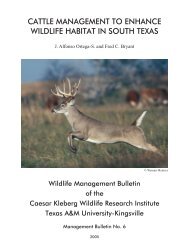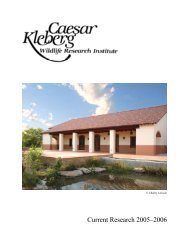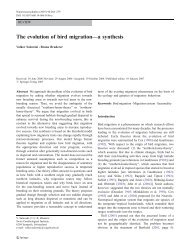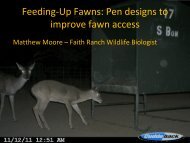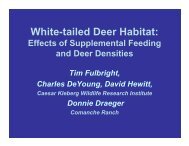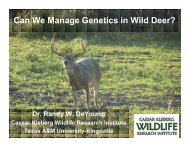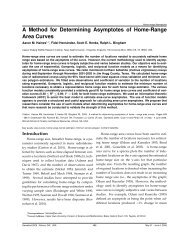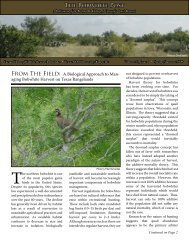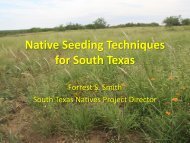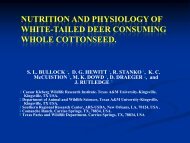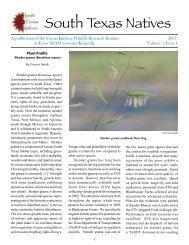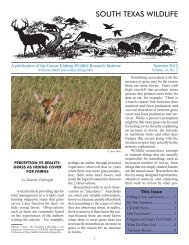The Northern Yellowstone Elk: Density Dependence and Climatic ...
The Northern Yellowstone Elk: Density Dependence and Climatic ...
The Northern Yellowstone Elk: Density Dependence and Climatic ...
You also want an ePaper? Increase the reach of your titles
YUMPU automatically turns print PDFs into web optimized ePapers that Google loves.
118 DENSITY DEPENDENCE IN YELLOWSTONE ELK * Taper <strong>and</strong> GoganJ. Wildl. Manage. 66(1):2002DISCUSSION<strong>Density</strong> dependence in the population growthrate of the northern <strong>Yellowstone</strong> elk herd isstrongly supported by several aspects of ouranalysis. First, a true a priori test (Dennis <strong>and</strong>Taper 1994) rejects the null hypothesis of densityindependence. This is more significant than thetest of density dependence for this populationreported in Dennis <strong>and</strong> Taper (1994). Two differencesbetween the current analysis <strong>and</strong> that ofDennis <strong>and</strong> Taper (1994) account for this change.First, we include the late period in our analysis,while Dennis <strong>and</strong> Taper (1994) worked just withthe early period. Second, we adjust for huntingmortality while Dennis <strong>and</strong> Taper (1994) did not.Perhaps, more appropriately, model identificationalso strongly supports density dependence inthe elk herd. In comparing the best density-independentmodel to the best density-dependentmodel, we find a AIC of 5.74. This indicates densitydependence is more than 300x more stronglysupported by the data than is the absence ofdensity dependence.Currently, the <strong>Yellowstone</strong> northern elk populationis capable of regulating itself. <strong>The</strong> populationequilibrium numbers in the absence of hunting(based on minimum counts) seem to besomewhere between 20,000 <strong>and</strong> 25,000 elk for thesize <strong>and</strong> quality of the current winter range.Undoubtedly, this underestimates the equilibriumpopulation size somewhat because of sightabilityissues.Our analysis indicates that although estimatesof the area of expansion are crude, the bulk ofthe population increase can be attributed to theexpansion of winter range to the north of YNP.Range expansion directly reduces density by increasingthe denominator in the ratio of populationsize to area occupied. Further, range expansionmay have a negative density-dependenteffect as the energetic dem<strong>and</strong>s of longer migrationsincrease at greater population sizes(Messier et al. 1988).Environmental changes have been involved to alesser extent in the increase in ecological carryingcapacity in the late period. Spring precipitationof the current year <strong>and</strong> spring precipitationsquared were identified as contributing effects.Calf:female ratios have been correlated positivelywith winter <strong>and</strong> summer precipitation 2 years earlier<strong>and</strong> negatively correlated with the previousyear's spring precipitation for 1970-1971 through1990-1991 (although the latter relationship wasonly marginally significant; Coughenour <strong>and</strong>Singer 1996). Other variables are included inmodels not statistically distinguishable from themodel including only current spring precipitation<strong>and</strong> density (Fig. 5). Further, the weathervariables are correlated, <strong>and</strong> thus, the identificationof predictive variables is not stable (Neter etal. 1996). A more secure statement is that environmentalfactors do contribute to elk populationdynamics.Singer et al. (1997) reported that Fames'(1996) winter severity index for the current yearwas not correlated with over-winter survival of elkcalves for winters 1968-1969 through 1991-1992.However, between 1987-1988 <strong>and</strong> 1990-1991,summer survival of radiocollared elk calves wasnot correlated with current year precipitation<strong>and</strong> over-winter survival of these calves was correlatedwith Fames' (1996) winter severity index forthe current winter. This may indicate an interactionbetween the effects of density <strong>and</strong> environmentalvariation in which winter severity has amore profound impact on calf (<strong>and</strong> adult) survivalunder conditions of high density. This patternhas been reported in other ungulate populations(Clutton-Brock et al. 1987, Choquenot1991). Winter carcass surveys during the lateperiod (Green et al. 1994) show a strong (adjustedR2 = 0.73) <strong>and</strong> significant (P= 0.02) regressionof elk carcasses on Fames' winter severity index(C. Schwartz, U.S. Geological Survey, personalcommunication).Our comparison of predicted <strong>and</strong> observedgrowth rates following the 1988 fire corroboratesthe simulation findings of Turner et al. (1994)that predicted a mild, but short-lived, increase inelk growth rate due to fire. Boyce <strong>and</strong> Merrill(1996) also modeled a post-fire peak <strong>and</strong> declinein the population size of the northern <strong>Yellowstone</strong>elk herd. However, the timing of the peak<strong>and</strong> the rate of return to background levels weobserve are much more rapid than thoseassumed by Boyce <strong>and</strong> Merrill (1996). Thus, inagreement with empirical work (Pearson et al.1995, Boyce <strong>and</strong> Merrill 1996, Vales <strong>and</strong> Peek1996) <strong>and</strong> the simulations of Turner et al. (1994)<strong>and</strong> Wu et al. (1996), we found that the 1988 firewas not responsible for the large decline in theherd from 1989 to 1990. <strong>The</strong> high 1988 populationsize <strong>and</strong> severe spring drought accounted forvirtually the entire decline. We also support theconclusions of these researchers that there was ashort-lived enhancement to elk habitat after thefire. This boost seems to have been in effect duringthe 1991-1992 <strong>and</strong> 1992-1993 years.



